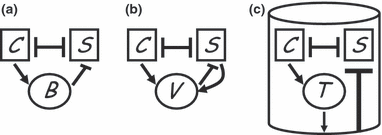Evolutionary ecology of microbial wars: within-host competition and (incidental) virulence
- PMID: 25567845
- PMCID: PMC3352407
- DOI: 10.1111/j.1752-4571.2008.00059.x
Evolutionary ecology of microbial wars: within-host competition and (incidental) virulence
Abstract
Invading an occupied niche is a formidable ecological challenge, and one of particular human importance in the context of food-borne microbial pathogens. We discuss distinct categories of invader-triggered environmental change that facilitate invasion by emptying their niche of competitors. Evidence is reviewed that gut bacteria use such strategies to manipulate their environment (via bacteriocins, temperate phage viruses or immuno-manipulation) at the expense of their competitors are reviewed. The possible virulence implications of microbial warfare among multiple co-infecting strains are diverse. Killing competitors can reduce virulence by reducing overall microbial densities, or increase virulence if for example the allelopathic mechanism involves immuno-manipulation. Finally, we place microbial anti-competitor strategies in a social evolution framework, highlighting how costly anti-competitor strategies can be understood as examples of microbial spite. We conclude by discussing other invasive species that have also developed such proactive strategies of invasion.
Keywords: disease biology; evolutionary theory; microbial biology; social evolution; virulence.
Figures

References
-
- Adams MH. Bacteriophages. London: Interscience Publishers Ltd; 1959.
-
- Alizon S, Van Baalen M. Multiple infections, immune dynamics and the evolution of virulence. American Naturalist. 2008;172:E150–E168. - PubMed
-
- Van Baalen M, Jansen VAA. Dangerous liaisons: the ecology of private interest and common good. Oikos. 2001;95:211–224.
-
- Billings WD. Ecology, Management and Restoration of Inter-Mountain Annual Rangelands. Ogdon Utah: US Forest Service; 1993.
Grants and funding
LinkOut - more resources
Full Text Sources

